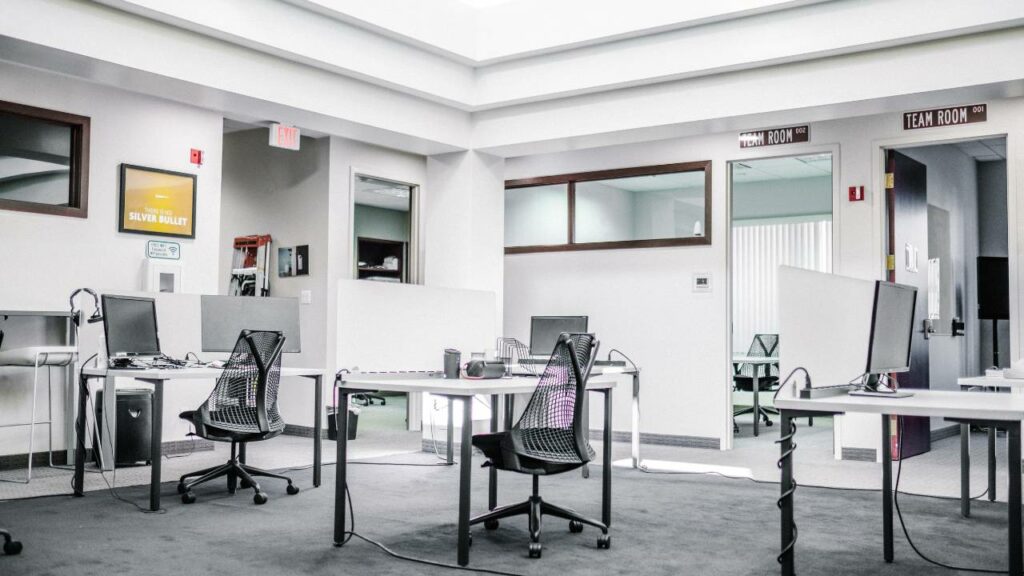A Comprehensive Guide to Seamless Business Relocation
Relocating your business can be a daunting task, especially when it comes to ensuring a seamless transition. Fortunately, with proper planning and guidance, you can navigate the process with ease and set your organisation up for success in its new location.
In this comprehensive guide, we’ll walk you through the essential steps for a smooth business relocation. From selecting the ideal location to managing employee transitions, you’ll be well-equipped to tackle every aspect of this significant change.
Understanding Business Relocation
Relocating your business can be a monumental task. Whether it’s due to growth, meeting new business needs or finding a more suitable location, office relocations require careful planning and consideration.
First, consider why your business needs to relocate. Are you expanding and need more space? Have you identified a better location to attract clientele or reduce expenses? Understanding the reasons behind your decision will help you form a clear plan of action.
Next, think about the timeline for your move. You may want to avoid disrupting your operations during peak periods, so choose a window that best suits your business’s needs. Keep in mind that the relocation process can take months or even years depending on the complexity, so set a realistic time frame.
In planning the actual move, it’s crucial that you keep your employees informed. Their understanding and cooperation will significantly ease the relocation process. Keep them updated on the progress and any changes that they should anticipate. Also, consider forming a relocation team to handle specific tasks and ensure a smooth transition.
Lastly, don’t forget to assess the logistical aspects of the move. This includes comparing costs of moving equipment, setting up infrastructure and reinstalling utilities in the new space. Creating a budget and being mindful of any financial constraints will be essential. Also, consider any potential obstacles related to your new location, such as licensing requirements or local regulations.
The Need for Planning and Preparation

A smooth business relocation process requires a great deal of planning and preparation. To achieve this, you’ll need to map out your timelines effectively and assemble a dedicated moving committee.
Effective Timeline Mapping
Creating a well-structured and realistic timeline is absolutely crucial for a successful move. You need to break down the process into manageable tasks and set achievable deadlines for their completion. To do this, consider factors such as the size of your office, the number of employees, and any specialist equipment you might have. You might consider enlisting the help of a professional removals company, like Halton Removals, to assist with the logistics and ensure everything stays on track.
Consider using a table or project-management tool to visualise your timeline, which will help you plan out the key tasks more effectively:
- Month 1 – Evaluate and select a new location
- Month 2 – Develop a moving budget
- Month 3 – Assign moving committee roles
- Month 3-4 – Arrange removal services
- Month 4 – Notify employees and clients
Role of a Moving Committee
Establishing a moving committee is a vital aspect of the planning and preparation stage. This team coordinates the entire relocation process, ensuring that everyone is on the same page and objectives are met in a timely manner.
- Assign responsibilities: Allocate roles to members of the committee, such as project manager, facilities manager, and IT specialist. This will ensure that every aspect of the move is covered by someone with the appropriate expertise.
- Schedule regular meetings: Keep everyone informed of the progress, address any unforeseen issues and adjust the timeline as needed. These meetings are crucial for maintaining open communication and boosting team morale.
- Liaise with external suppliers: Your moving committee should be responsible for coordinating with external parties, including removals companies, utilities providers, and IT services.
Employee and Stakeholder Engagement
Proactive Communication
Engaging with employees and stakeholders during a business relocation is crucial. To achieve a successful move, make sure you keep everyone informed by maintaining open, transparent channels of communication. This can include regular email updates, meetings, and providing a platform for people to ask questions or voice concerns. Clear and honest communication helps alleviate anxiety and fosters trust as you progress through the transition.
Positive Team-Building
While relocating can be stressful, you can use this opportunity to build a stronger work environment through team-building activities. Encourage your employees to get involved in the planning process. Organise events, both online and offline, to foster camaraderie and collaboration amongst your teams. By including your employees in the decision-making process, you help create a sense of ownership and pride in your company. By approaching relocation with a positive attitude, you’ll strengthen the bonds between your team members and create a more cohesive workspace once settled into the new location.
Crafting a Detailed Relocation Plan

Those seeking to relocate their businesses with ease must create a comprehensive plan. In this section, we will discuss how to craft a detailed relocation plan which includes essential checklists, budget calculations, and task delegation.
Essential Checklist Creation
Before diving into the relocation process, it’s vital to create an all-encompassing checklist. A well-thought-out checklist will ensure that no detail is overlooked, and your relocation goes smoothly. Here are some key aspects to consider:
- Inventory: List all the office equipment, furniture, and supplies you have. This will help you understand what needs to be moved and what can be sold or donated.
- Timeline: Allocate a specific time for each task on your checklist and establish deadlines. This way, you can keep track of the progress and ensure timely completion.
- Legal and regulatory requirements: Review local laws and regulations that may affect your business during the relocation, such as permits, insurance, and safety guidelines.
- Communication: Keep stakeholders informed about the relocation plan by providing relevant updates and answering questions.
Budget and Costs Calculation
It’s important to establish a clear budget for your business relocation. Make sure you cover all the financial aspects that will play a part in the process. Consider the following:
- Moving expenses: With the help of your accountant, factor in the cost of hiring professional movers, packing materials, and transportation. Be sure to get quotes from several moving companies and compare their services.
- Rent or property expenses: Determine the cost of your new office space. Consider the rent, any necessary improvements or renovations, and potential changes in utility costs.
- Insurance: You’ll need to budget for adequate insurance coverage for your move. This may include liability insurance, property coverage, and workers’ compensation.
- Unforeseen costs: Set aside a contingency budget for unexpected expenses that may arise during the relocation process.
Don’t forget to delegate tasks amongst your team members. This ensures everyone is clear on their responsibilities, leading to a smoother relocation experience. Key tasks to delegate include:
- Packing and organising equipment
- Coordinating with service providers
- Managing paperwork and permits
- Ensuring employee and stakeholder communication
Managing Inventory and Layout
When relocating your business, managing inventory and layout plays a crucial role in ensuring a smooth transition. In this section, we’ll discuss rationalising furniture and equipment and preparing your new workspace.
Rationalising Furniture and Equipment
Before moving, it’s essential to declutter and organise your furniture and equipment. This process allows you to identify unnecessary items and save both time and resources during the relocation. Begin by creating an inventory list categorising all the items you’ll need in your new office.
To declutter efficiently, follow these steps:
- Evaluate all furniture and equipment based on their condition, usage, and compatibility with your new workspace layout.
- Donate, sell, or dispose of items that no longer serve your needs or don’t fit in the new office.
- Label each item with its destination for the inventory management process.
New Workspace Preparation
Once your inventory is organised, begin preparing your new workspace layout. Take time to plan the furniture arrangement and equipment placement to ensure it meets your operational needs and optimises available space.
Consider these factors when preparing your new workspace:
- Functionality: Make sure your layout promotes efficient work processes and accommodates any specific needs such as private offices or collaborative spaces.
- Aesthetics: Create a visually appealing and professional environment with well-organised furniture and equipment placement.
- Ergonomics: Ensure your furniture and equipment provide comfort and enable healthy work habits to promote employee well-being.
Transition to the New Office
Testing Utilities and Services

When relocating to your new office, it’s essential to ensure all utilities and services are functioning properly. Start by examining the electricity, water, and gas connections. If necessary, schedule a visit from service providers to check the installations and confirm their efficiency. This process will help you avoid unexpected issues during the transition.
Next, verify the availability of facilities such as heating, air conditioning, and security systems. Proper testing of these systems is key to maintaining a comfortable and safe environment for your employees.
Implementing Phone Systems and IT Infrastructure
Setting up phone systems and IT infrastructure is vital for seamless communication and workflow in your new office. Begin by researching the best telephone and internet service providers in the area, and explore their package options. Compare the features and costs while considering your company’s requirements.
Once you’ve chosen a provider, schedule installation and setup services well in advance to avoid any delays in productivity. During this process, ensure all necessary equipment is readily available, such as phones, network switches, servers, and cables.
It’s also important to organise your IT setup systematically. This includes arranging desks and workstations with proper cable management, implementing security measures, and assigning suitable network access to employees.
Don’t forget to inform your staff about the new setups and systems in place. Providing training and support for any unfamiliar technology will make for a smoother transition to the new office.
Logistics Management
When it comes to business relocation, managing logistics is a critical aspect. To ensure a smooth transition, you need to carefully plan and execute each step of the process, from hiring professional movers to obtaining the necessary permits and insurance.
Choosing Professional Movers
Selecting the right moving company is essential. Look for movers with experience in relocating businesses, as they are more likely to understand the specific challenges and requirements involved. Consider the following tips:
- Seek recommendations from your network, and read reviews online
- Obtain quotes from several companies for comparison
- Check if they offer packing and unpacking services, as well as IT equipment relocation
Ensuring Insurance and Permits
It’s crucial to verify that your chosen moving company has the necessary insurance and permits before starting the relocation process. As a client, you need to:
- Confirm that the movers have public liability insurance and goods in transit coverage
- Ensure that proper permits have been acquired for parking and loading at both the origin and destination premises
- Check your own company insurance to understand what might be covered during the move
When the big day finally arrives, make sure to keep communication lines open with your movers, IT service provider, and your staff. Timely updates and coordination will help guarantee a seamless relocation experience for your business.
Mitigating Disruption and Maintaining Productivity

Relocating your business can be a daunting task, but with the right strategies, you can minimise disruption and maintain productivity throughout the process. In this section, we’ll go over some key downtime minimisation strategies and explore a variety of backup and storage options to help make your move as seamless as possible.
Downtime Minimisation Strategies
- Plan ahead: Proper planning is essential for reducing downtime. Start by creating a detailed relocation timeline and assign tasks to specific team members. This will ensure everyone knows their responsibilities and deadlines, making the transition smoother.
- Communicate effectively: Keep your team up-to-date on relocation plans and progress. Regular communication helps to prevent misunderstandings and ensures everyone is prepared for each stage of the move.
- Hire professional movers: Investing in professional moving services can save time and minimise disruption. Experienced movers can help you pack, transport, and set up your new office efficiently, reducing downtime and allowing your team to focus on business operations.
Backup and Storage Options
During a business move, it’s crucial to ensure the safety of your company’s data and files. Here are a few storage solutions to consider:
- Cloud storage: Keep your data securely stored in the cloud, accessible from anywhere with an internet connection. This is an excellent option for organisations with remote employees, as it allows them to maintain productivity even during the relocation process.
- Physical backups: Create copies of essential files and documents, stored on external hard drives or other storage devices. Keep these backups at a secure offsite location to protect against loss or damage during the relocation.
- Secure storage facilities: If you need to store physical items, such as inventory or equipment, consider using a secure storage facility. These facilities offer various levels of security, ensuring that your business assets remain safe and protected throughout the relocation process.
Post-Relocation Tasks
Update Business Contacts and Online Presence
Once your business relocation is complete, it’s essential to update your online presence. This includes updating your website, social media accounts, and contacting your clients and customers to inform them of your new location. Ensure that you:
- Edit your website’s contact page with your new address, phone numbers, and email addresses.
- Update the profiles and business details on all your social media accounts, such as LinkedIn, Facebook, Twitter, and Instagram.
- Send out a mass email or newsletter to your clients and customers to let them know about your new location and any potential changes in your services.
- Review and update your Google My Business account to help maintain visibility in local searches.
Arrange for Potential Renovations
Depending on the condition of your new premises, you might need to arrange for some renovations or remodelling to suit your specific business needs. Here are some tasks to consider:
- Evaluate the new space and note any necessary repairs or modifications.
- Create a timeline and budget for the renovations, taking into account any potential disruptions to your daily operations.
- Consult with professional contractors, designers, or architects to discuss your ideas and obtain quotes.
- Coordinate the renovation scheduling and allocate responsibilities for overseeing different tasks.
- Monitor the progress of the renovations and keep your team informed about any updates or changes.
Conclusion
While business relocation can be a daunting task, by following these guidelines and ensuring thorough preparation, you can be confident of a smooth and stress-free relocation experience.
Best of luck with your next move, and may your new location bring continued success and growth to your business.

